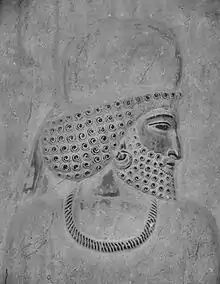Kolah namadi
Kolah Namadi ((Persian: کلاه نمدی), Kolāh namadī, pronounced: kolaah namadee) is a traditional Persian wool felt hat worn by men in parts of Iran.[1] They come in variety of colours and shapes depending on the region in Iran or the clan that wears it. Today they are worn mostly for ceremonial purposes.[2]

Etymology
Kolāh is the Persian word for hat whereas namad is the type of material the hat is made from. Together the word Kolāh namadī means a hat made of [the material] namad.[3]
Process of production

Kolah Namadi is a felt hat made out of wool. The hat is made out of sheep, camel or goat hair wool and compressed using heat and water. The wool is mixed with a binding material such as starch, oil, grease, eggs or soap and then given its form using a mould. The hat is shaped into the style specific to the people of the region.[4]
History
The technique of felting was originally devised in Central Asia in 5th to 3rd Century B.C.[5] Historically wearing a hat was a symbol of honour and pride among Iranian men.[6] Reliefs dating back to ancient Persia illustrate Kolah Namadi and were regular features of Persian and Greek Art.[7][8] In early twentieth century, Iranian gangs of men used to wear Kolāh namadī as an essential part of their identity and pride.[9]
In popular culture
Kolah Namadi is regularly featured in Iranian historical films. A 1966 romance film was also given the title Kolah Namadi (The Felt-Hatted Man)[10]
References
- Steingass, F (1998), Persian-English Dictionary: Including Arabic Words and Phrases in Persian, Routledge, ISBN 9781136852480, p.1041
- Balslev, Sivan (2019), Iranian Masculinities: Gender and Sexuality in Late Qajar and Early Pahlavi Iran, Cambridge University Press, ISBN 9781108470636, p.214
- Steingass, F (1998), Persian-English Dictionary: Including Arabic Words and Phrases in Persian, Routledge, ISBN 9781136852480, pp.1040-1041
- Balland, Daniel, Digard, Jean-Pierre (2012), FELT, Encyclopaedia Iranica, Vol. IX, Fasc. 5, pp. 484-489
- Balland, Daniel, Digard, Jean-Pierre (2012), FELT, Encyclopaedia Iranica, Vol. IX, Fasc. 5, pp. 484-489
- Balslev, Sivan (2019), Iranian Masculinities: Gender and Sexuality in Late Qajar and Early Pahlavi Iran, Cambridge University Press, ISBN 9781108470636, pp.213-214
- Slater, William J. (1995), Dining in a Classical Context, The University of Michigan, ISBN 0472101943, p.62
- Balland, Daniel, Digard, Jean-Pierre (2012), FELT, Encyclopaedia Iranica, Vol. IX, Fasc. 5, pp. 484-489
- Naficy, Hamid (2011), A Social History of Iranian Cinema, Volume 2: The Industrializing Years 1941-1978, Duke University Press, ISBN 978-0822347743, p.283
- The Felt-hatted Man (1966) Kolah namadi (original title)(accessed=March 21, 2020)